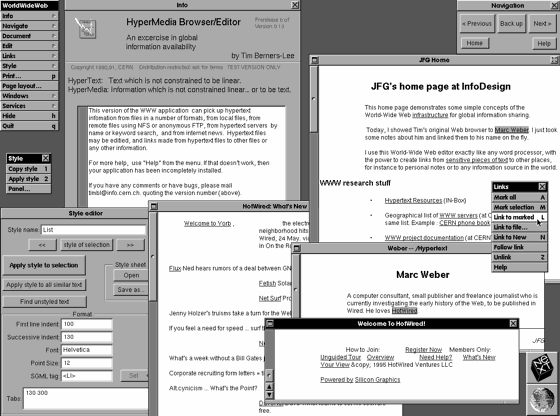Did you know…?
The first web browser — or browser-editor rather — was called WorldWideWeb as, after all, when it was written in 1990 it was the only way to see the web. Much later it was renamed Nexus in order to save confusion between the program and the abstract information space (which is now spelled World Wide Web with spaces).
I wrote the program using a NeXT computer. This had the advantage that there were some great tools available — it was a great computing environment in general. In fact, I could do in a couple of months what would take more like a year on other platforms, because on the NeXT, a lot of it was done for me already. There was an application builder to make all the menus as quickly as you could dream them up. there were all the software parts to make a wysiwyg (what you see is what you get — in other words direct manipulation of text on screen as on the printed — or browsed page) word processor. I just had to add hypertext (by subclassing the Text object).
It’s been nearly seventeen years since Apple acquired NeXT, and made NeXT’s OS and developer technologies the foundation for what would become Mac OS X. In the time since, Mac OS X (now just “OS X”) has advanced considerably beyond its NeXTSTEP beginnings. Yet many of the same developer-productivity-enhancing fundamentals, and the software engineering insights that gave rise to them, still underpin the OS X we know today — from the multiprocessor-ready Mach kernel, to the dynamic, loose-coupled Objective-C language, to the application frameworks that provide versatile software building blocks.
As a longtime fan of the technology that began life at NeXT, and whose further development I enjoyed the privilege of contributing to while at Apple, I’ve found a special bit of delight in developing an HTML editor on OS X using modern-day descendants of NeXT’s revolutionary frameworks and tools. TypeMetal isn’t alone in this category, but it does represent a fundamental shift in the way we write for the Web — innovating aggressively in ways that I believe will greatly improve Web content authors’ productivity, while making the process a lot more fun. I’m still experiencing the most fun and greatest productivity I’ve ever enjoyed, developing apps on OS X — factors that I’m certain have contributed greatly to TypeMetal’s successful development and to the powerful functionality it offers.
HTML has also evolved since the dawn of the Web, and there’s a great deal more to writing a full-fledged HTML editor than simply “subclassing the [NS]Text object”, as I can readily attest after the 20 months of intensive development that produced TypeMetal 1.0. But tackling the challenge of generalized, Undo-able DOM tree editing opens doors to a whole new way of intelligently, symbolically working with our content. There’s great power and potential encapsulated in TypeMetal’s innovative editing engine, and I look forward to the even greater innovations that its groundbreaking foundation will make possible in the future.
Follow @CoherenceLabs on Twitter, and subscribe to our RSS feed, to keep apprised of the latest developments!
I wrote this post using TypeMetal with WordPress.
